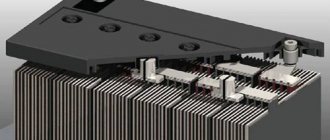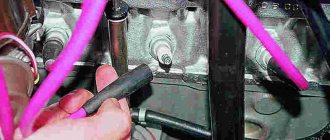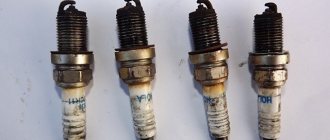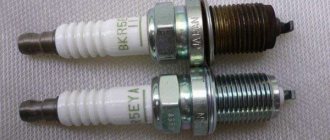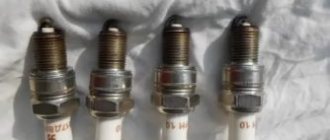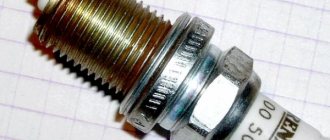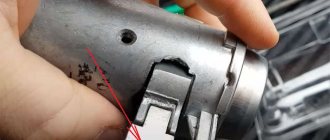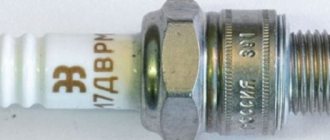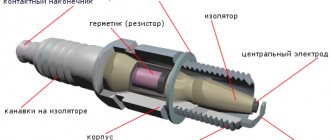A large number of motorists, while operating a vehicle, periodically encounter difficulties starting the power unit. In this case, quite often there are no obvious prerequisites in the form of clearly manifested malfunctions. An unexpected engine failure to start can occur both during a cold start and when trying to start a previously warmed-up internal combustion engine. In such cases, one of the most common reasons why a car engine does not start is that the spark plugs in the engine are filled with gasoline or oil.
We also recommend reading the article about why a hot engine won’t start. From this article you will learn why a warm gasoline engine with an injector and carburetor may not start, and why a diesel engine may not start when hot.
If the spark plugs on an injection engine or carburetor unit are flooded, starting the engine will be very difficult or completely impossible. This indicates the presence of certain problems both with the engine itself and with individual elements and systems. In this article we will talk about why spark plugs flood, how to understand why the spark plugs are flooded, and also what a driver should do if the car does not start, fill the spark plugs with gasoline or motor oil, etc.
Why do the spark plugs flood when starting the engine when cold?
Let's start with the fact that in the warm season the problem of flooding candles is not as pressing as in cold weather. As a result, it becomes more common that the car's spark plugs flood in the cold. The main signs of flooded candles:
- the problem manifests itself in such a way that the crankshaft is cranked by the starter, but the engine does not “catch”;
- there is a smell of gasoline coming from the exhaust pipe, the smell is distinct when the engine is cranked by the starter;
- after unscrewing the spark plugs, the threads and electrodes are in gasoline, and dark carbon deposits are also present at the bottom of the spark plug;
Let us add that fuel filling occurs regardless of what power system is installed on a particular vehicle (engine with injection injection or carburetor version). The only thing, if you compare the injector and the carburetor, fills the spark plugs on the injector in cold weather somewhat less often. Also, some filling features may differ slightly, taking into account the individual characteristics of a particular power system.
So, the spark plugs flood (especially at subzero temperatures) as a result of the fact that fuel enters the combustion chamber from the power system, but the fuel does not ignite. The spark plugs become wet, after which the further normal process of spark formation becomes impossible, that is, the engine will no longer be able to start.
As practice shows, the list of reasons why spark plugs fill on a cold injector or when a similar problem occurs on a carburetor car includes several main points:
- Low battery charge. In this case, the battery is discharged by more than 40-60%. When the outside temperature drops, the battery may not produce the required power sufficient for normal operation of the starter and the functioning of the ignition system. As a result, fuel is supplied by the power supply system to the cylinders, but ignition does not occur and the fuel floods the spark plugs.
- Ignition system malfunctions. Problems can arise both with the spark plugs themselves and with the high-voltage wires. If the spark plugs are old, then they may have incorrect gaps, various defects in the body and electrodes. The spark on such spark plugs may be weak or absent. As for high-voltage wires, they can be damaged, contacts fail, etc. At the same time, you should also check other structural elements of the ignition system, which may cause the lack of a spark on the spark plug.
- Low quality fuel. In winter, the ease of ignition during a cold start greatly depends on the purity and total amount of impurities in the fuel. It should also be taken into account that in winter condensation may accumulate in the fuel tank, which also ends up in gasoline. The combination of such factors leads to the fact that there is a spark on the candles, but the fuel cannot ignite in a timely manner. The result is a non-working engine and wet spark plugs.
We also recommend reading the article on how to properly charge a car battery with a charger if it is maintenance-free. From this article you will learn about the features of charging such batteries, what parameters need to be observed and set on the charger, as well as how to fully charge the battery without harm to the battery.
In practice it looks like this. For example, on injection engines, the ECU takes into account the outside and engine temperature, the amount of oxygen in the air entering the engine, etc. The control unit sends the appropriate command to the injectors to increase the amount of fuel if necessary, that is, it enriches the fuel-air mixture for a confident cold start and further stable operation of the power unit (the so-called warm-up speed XX). In accordance with the signal received from the ECU, the injection nozzles inject more fuel.
Now let's imagine that the engine is no longer new, that is, there is some wear on the CPG. This means that the compression in the cylinders is still within acceptable limits, but is no longer ideal. You can also add to this a slightly weak battery, thickened oil in the engine crankcase and deposits on the spark plugs. It turns out the following:
- injectors actively supply fuel that is not the best quality into the cylinders, which also does not evaporate well at low temperatures;
- the starter slowly turns the crankshaft in thickened lubricant from an undercharged battery;
- in a cold engine, parts do not expand due to heating, gaps are increased, compression is reduced;
- the ignition system generates a weak spark on dirty spark plugs, which is not enough to ignite the fuel-air charge;
Of course, the above example describes a whole range of possible problems. However, taking into account the above, it becomes clear that each “link”, even taken separately, can already lead to difficulties during start-up and certain failures. In other words, problems with the battery or high-voltage wires alone may be enough for the driver to fill the spark plugs in the winter after one or two unsuccessful attempts to start. It turns out that the minimum impulse to ignite the fuel is simply not enough or there was no spark to begin with. Separately, we would like to add that if a spark plug on a cylinder is flooded, and only one turns out to be problematic, then we should not exclude the possibility of low compression or other problems only in this particular engine cylinder.
Tags
appearance of oil in oil appearance of oil in contact with oil oil level in the ability of oil to pass oil into the ability of oil to get into valve stem seals presence of oil on Motor oil Motor oils Motor oils Motor oils Motor oils Motor oils Motor oils in engine oils Motor oils Motor oils allow oil to pass into valve stem seals valve stem seals
motormaterialssystemsealantventilationcleanersgetadditivescolorsituationcartransmissionspecialvas
There is a spark, the starter turns normally, but the spark plugs are flooded
Quite often you can encounter a situation where there is a spark, the spark plugs are flooded, and the starter spins the crankshaft well. In such a case, the spark plugs may require a separate check, since the presence of a spark on them does not mean that the same spark will always be created under pressure. In other words, if there was a spark on the unscrewed spark plug, then after installation on the engine it may disappear. The reason is increased pressure in the combustion chamber, which is created during the operation of the internal combustion engine. To find out, you need to carry out diagnostics on a special stand for checking spark plugs, which simulates the operation of these elements taking into account high pressure (similar to the operation of spark plugs in the combustion chamber).
Also, attention should be paid to the valve timing, since their failure may be the cause of flooded spark plugs. Note that on engines with an injector, problems with the bypass valve in the fuel rail are also possible. To eliminate the possibility of its malfunction, you will need to measure the fuel pressure in the rail. It is important to understand that fuel must be supplied to the cylinders under a certain pressure. Deviations, both upward and downward, can lead to flooding of spark plugs and the inability to start the internal combustion engine.
At the same time, the injectors themselves and ECM sensors may need diagnostics. For example, in the event of a malfunction, the coolant temperature sensor may send incorrect data to the computer. In this case, the control unit enriches the mixture and the injectors overflow fuel. In rare cases, the electronic engine control unit itself fails.
Video with example: how to solve the problem on the 1G-FE motor
There is probably no driver who has not encountered the problem of flooded spark plugs. In the evening the car runs fine, in the morning the engine does not want to start. This fact indicates the presence of certain problems in the car. After the engine has cooled down, the temperature, pressure and other parameters in the systems have changed, and the engine may well not start when it is “cold”.
Fills spark plugs with engine oil
In addition to the fact that the spark plugs can be filled with gasoline, there are common cases when the spark plugs in the engine are filled with oil, a spark plug in one cylinder is filled with oil, etc. This malfunction occurs both on the injector and on engines with a carburetor.
If the candles are filled with oil, then you should more accurately determine how the candles are filled, from above or from below, that is, which part of the candle is contaminated. An accumulation of grease at the top (in the spark plug wells) indicates that, for example, there are problems with the valve cover gasket or other seals. In this case, the ingress of oil leads to the spark starting to break through and the cylinder or several cylinders as a result do not work.
After unscrewing the spark plug, obvious black deposits may be visible or absent on the threads; oil may also fall from the well directly onto the threads while unscrewing the spark plug, etc. In the case when the spark plugs are filled with oil from below, that is, in the cylinder itself, then the compression in the engine should be measured. There is a high probability that the oil scraper rings are badly worn, cracked or stuck. It is also possible for cylinder walls or liners to wear out, oil seals (valve seals) to fail, cracks to appear in the cylinder head, problems with valve guides and other malfunctions that lead to increased lubricant entering the combustion chamber and oiling of the spark plugs.
Why does oil appear in the distributor and what to do to eliminate it
- Why does oil appear in the distributor and what to do to eliminate it
- Why does oil appear in spark plug wells?
- What is the danger of oil getting into wells?
- We carry out phased repairs
Each make and model of car has its own distinctive features. For example, the VAZ ten very often suffers from the fact that its spark plug wells are often “bathed” in oil after a certain period of operation. The reasons for the occurrence of such trouble can be very different, but one thing is certain: it depends to one degree or another on the type of engine. In this article we will look at where this problem comes from and how to clean the spark plug well from oil that has got into it.
The spark plugs are flooded: what should the driver do?
Let's say the engine won't start and you are sure that the reason is the gasoline on the spark plugs. In such a situation, it is useful to know what can be done if the spark plugs are flooded, how to start the car in such conditions, etc.
Let's start with the fact that there are several available ways to dry flooded candles. To begin with, the instruction manual for many cars specifically states that if the spark plugs on an injection engine are filled with gasoline, then they need to be unscrewed using a spark plug wrench and dried. Then the engine should be cranked with the starter for about 10 seconds with the spark plugs removed. Next, the spark plugs are screwed back in, after which an attempt is made to start the internal combustion engine in normal mode.
Also, many drivers, if the spark plugs are flooded, start the engine with cylinder purging. In some cases, this method allows you to start the engine without removing the spark plugs. To purge the cylinders on an injection engine, you need to press the gas pedal all the way before starting. Next, the starter cranks the crankshaft for about 10 seconds, then the gas pedal can be released. Such actions help the power unit start. Purge occurs due to the fact that when the throttle valve is open, a large amount of air enters the cylinders, and the spark plugs dry out.
If the engine does not start with purging, then the spark plugs will have to be dried manually and their condition assessed. To do this, they need to be unscrewed, after which the carbon deposits are cleaned. You can use a soft brush (a toothbrush will do) or a brush with metal bristles. In the second case, you need to be careful and clean without effort. Candles are dried with a household or hair dryer, calcined on a gas burner, and placed in the oven. Next, you need to check the gap between the electrodes, after which you can screw the elements back into the engine. As a result, restarting should proceed without difficulty.
Let us add that many experts recommend not implementing the solutions described above if it is possible to immediately purchase new spark plugs. In simple words, cleaning and calcination leads to the fact that the service life of the spark plug after such actions is noticeably reduced, the gaps are lost, and these elements work worse after cleaning. It turns out that it is more profitable to purchase relatively inexpensive new spark plugs than to clean, dry and then reinstall the old ones. It is also noted that it is advisable to change simple spark plugs from the average price range every 15-25 thousand kilometers traveled, regardless of their condition and appearance.
It should also be taken into account that if new or cleaned spark plugs are constantly flooded, then the cause must be looked for separately, and not just solve the problem by cleaning or changing these elements. In this case, the engine needs in-depth diagnostics; the ignition system, injectors, ignition coil, Hall sensor, temperature sensor, etc. are checked.
How to make a puller?
Everything is very simple and cheap. To assemble this tool, you need to have a metal pin at least 15 centimeters long, a piece of rubber hose with a diameter of 20-25 millimeters, several washers, nuts and one bushing. What to do with all this? First, a washer is put on a long pin, then an elastic band, a bushing and nuts. That’s it – the spark plug well sealing ring remover has been successfully completed! The cost of such a tool is no more than 100 rubles, and it can be made in almost a few minutes. This way you will very quickly remove oil from the spark plug wells. Priora and many other models of domestic cars are repaired using this tool.
Make sure that the elastic is clamped on both sides with washers. In this case, the diameter of the latter should be as close as possible to the width of the spark plug well itself. Otherwise, the clamped rubber will crawl out into the gap between the well and the washer, and we don’t need this.
The pull handle is made of a valve nut. The lower washer should rest against the tip of the stud, and the upper one should be pressed by the bushing.
So, let's start the renovation. First, the puller is inserted into the spark plug well, after which the lower nut is tightened until the axial movement of the tool allows us to pull out the well. After a little effort, the glass will be successfully removed.
During the work, make sure that the rubber part of the inserted puller does not protrude beyond the well. Similar to the first case, we install new oil seals, lubricate them with oil and assemble them in reverse order. By the way, the installation process will take you less time than dismantling.
Let's sum it up
Taking into account the above, it becomes clear that for normal starting and operation of the engine it is necessary to create certain conditions. It is also important to remember that increased requirements are put forward in winter. In an effort to achieve a stable start, novice car enthusiasts often ask which spark plugs do not fill. You can immediately answer that in the event of a malfunction, any spark plugs will flood, even new ones. This happens regardless of the brand, the condition of the candles themselves, design features, brand, etc.
Please note that to prevent gasoline from flooding the spark plugs, you must:
- monitor the battery charge, recharge the battery using a charger;
- the starter must be in good working order; jamming, slipping, etc. is not allowed;
- The engine must be filled with oil that corresponds to the current operating conditions (viscosity suitable for winter, as well as other parameters);
- The power supply system must be absolutely in good working order, the injector nozzles must be cleaned in a timely manner. For cleaning, it is advisable to resort to more effective methods of cleaning injectors with ultrasound or to wash the injector on a special washing stand, and not limit yourself to just preventive additions of various cleaners to the fuel tank;
- It is advisable to refuel only at proven gas stations that have certificates confirming the quality of the fuel;
- regularly check the condition of spark plugs and high-voltage wires;
In order to prevent carbon formation in a working engine, experts recommend periodically spinning the power unit to high speeds (about 4500-5000 rpm), after which you need to drive at least 30-50 km in this mode. This is especially true for cars that are constantly used in urban environments. Factors such as: prolonged operation at idle, short trips in low gears, low revs and driving at low speeds, underheating of the engine (the unit does not have time to fully reach operating temperature) lead to increased accumulation of carbon deposits and engine coking. Increasing the speed and load above the average level allows for partial cleaning of soot and deposits in the combustion chamber of the internal combustion engine in a natural way.

